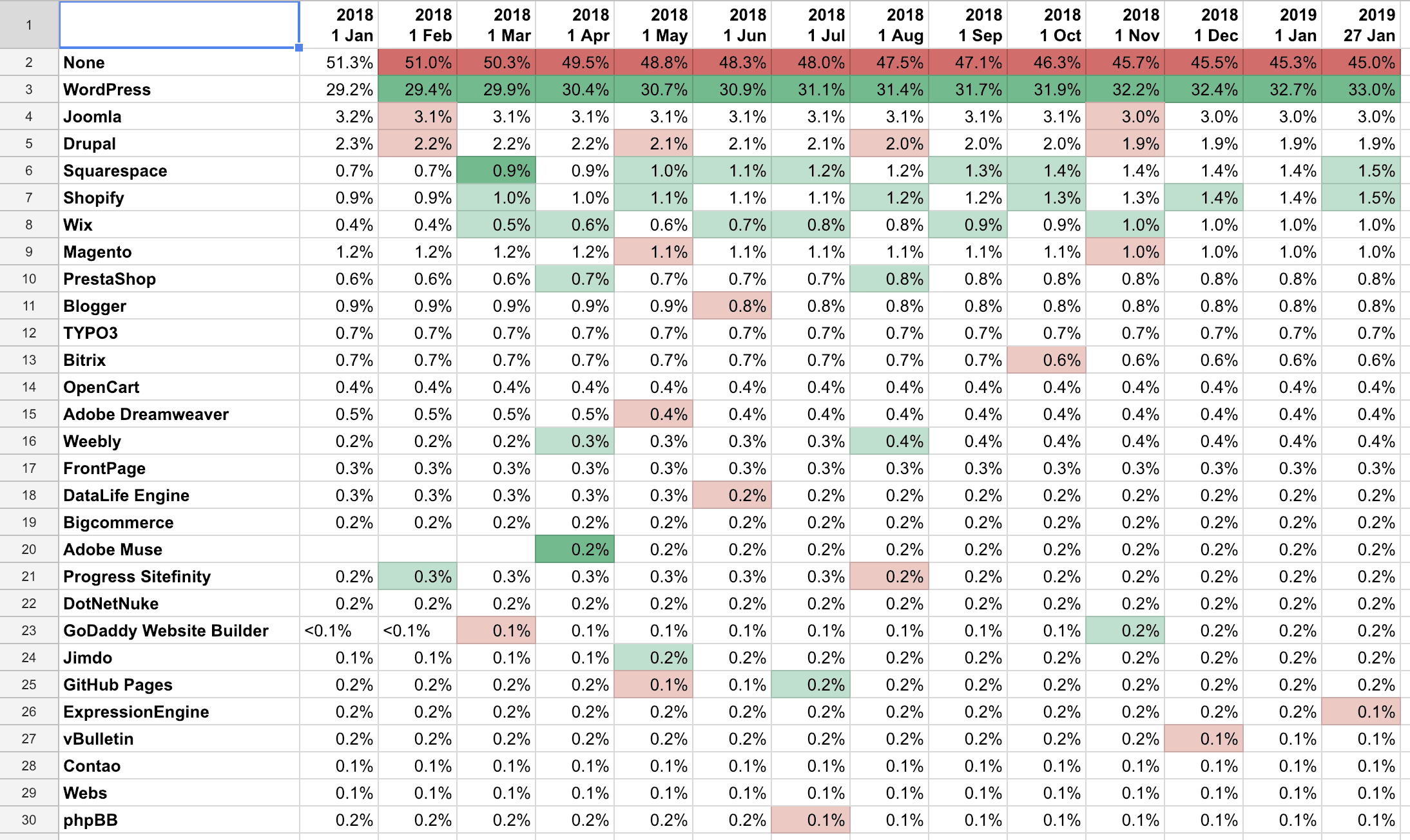CMS Market Share
January 2019 Analysis

Every 6 months I analyze the CMS market share numbers provided by W3Techs in depth. I look at the top 10 CMSes, which content management systems have grown, which have shrunk. I always pay special attention to eCommerce platforms as well.
I do these analyses biannually. The latest one can always be found here: CMS market share analysis.
Estimated reading time: 5 minutes
As I’m getting into my new role as Marketing Lead for WordPress, I was doing an analysis of the CMS market share numbers. The first thing I noticed was that, according to W3Techs, WordPress’s market share had yet again grown, to now have 33% of the top 10 million sites. As I was diving deeper, the numbers in the W3Techs research show some very interesting trends. I thought I’d share what I’m seeing.
WordPress’s market share is huge
The first thing that’s obvious when you look at these numbers is that WordPress’s market share is absolutely huge. At 33% it’s now 11 times bigger than the number two in the market, another open source CMS: Joomla. I’ll be very happy when we add another .3% and can say that we’re “a third of the internet”.
When you look at the raw numbers, it’s clear that only a few of the CMSs are making any real moves. I’ve highlighted the growth and decline per month over the last year in the screenshot below.

Note that the “None” group in this data, with 45% market share, doesn’t mean that 45% of sites are coded by hand. It means that W3Techs did not recognize the CMS (and it recognizes a lot of them), and the CMS is thus probably bespoke. The trends are very consistent though: people are moving to known CMSs and very few CMSs grow one month to decline the next. You’re either growing, or shrinking, with very little exception.
Relative growth and trends
Because WordPress is so big, looking at absolute growth only tells you so much. If we start looking at relative growth, we can see who our new competitors really are. As soon as you start looking at relative growth for the top 20, three systems jump out:
- Squarespace, which grew 114%.
- Wix, which grew 150%.
- Weebly, which grew 120%.
It’s noteworthy that Prestashop, an eCommerce system / CMS, also grew its market share by a very respectable 67%. WordPress grew by “only” 13%, which considering the marketshare it already has, is still massive. But what I was looking for was in the next step: what if all these systems maintained the growth or decline they had in 2018 for another year? If they do, the top 10 of CMSs would look starkly different to today:
| CMS | 2020 forecast | 2019 ranking | 2018 ranking |
| WordPress | 1 | 1 | 1 |
| Squarespace | 2 | 4 | 7 |
| Joomla | 3 | 2 | 2 |
| Shopify | 4 | 4 | 5 |
| Wix | 4 | 6 | 12 |
| Drupal | 6 | 3 | 3 |
| Prestashop | 7 | 8 | 10 |
| Magento | 8 | 6 | 4 |
| Weebly | 9 | 12 | 16 |
| Blogger | 10 | 8 | 5 |
While WordPress will remain number 1, the rest of the top 10 will change dramatically.
Open source on the decline?
At the beginning of 2018, the top 4 CMSs by market share in the world were all open source: WordPress, Joomla, Drupal and Magento. So I also dove in and checked whether Open Source as a whole was losing or winning. The numbers are clear, based on the top 25 CMSs (including all the sites that fit in W3Techs “None” category, classified as closed source):
| 2018 | 2019 | Forecast 2020 | |
| Open source | 37.8% | 41.0% | 44.9% |
| Closed source | 57.1% | 53.0% | 51.7% |
On the whole, Open Source marketshare is growing, but really only because of WordPress and a tiny bit of help from Prestashop. I think this is worrying. We’re losing diversity in the CMS market and with it we’re losing open source alternatives.
Financial ramifications
Consider this:
- Shopify expects to do about 1 billion USD in revenue in 2018, with 1.5% marketshare.
- Wix expects to do about 600 million USD in revenue in 2018, with 1% marketshare.
- Squarespace reportedly had 300 million USD in revenue in 2017, when it was still much smaller.
I think it’s not unfair to extrapolate these numbers for theses CMSs and compare them to WordPress’s 33% market share. If we do that then WordPress as a whole is indeed, as Matt said in his State of the Word, a $10 billion industry. In fact when he says that he might even be on the low side.
There’s one difference which we may need to address though: WordPress doesn’t spend a percentage of that $10 billion on marketing. The CMSs that are growing their market share so aggressively are spending a lot of money on marketing, and it’s clear that it’s working. It’s not a problem yet, but we’ll need to be more creative and keep an eye on this.
CMS Market Share Data
I imported all this CMS market share data from W3Techs into a Google Sheet. The sheet, including some of my highlights and forecasts is public and you can view it here. I’d love to hear what else you see that strikes as odd or needs attention.

Joost de Valk
Joost is an internet entrepreneur from Wijchen, the Netherlands. He is the founder of Yoast. Joost is married to Marieke, who is also Yoast’s former CEO. Marieke and Joost have 4 kids together and run Emilia Capital together, an investment firm.

Interesting analysis. IMO closed-source isn’t gaining ground just because they’re spending money on marketing. Closed source options tend to “just work” and are so much simpler. Even though I believe quite strongly in the importance of free software, it’s a pretty hard sell when people just want their website to work (and don’t really understand all this “open-source mumbo-jumbo”.)
I feel it’s rather enlightening that Magento is loosing ground to Prestashop when it used to have such an outstanding lead on other eCommerce CMS just a year or two ago. I think many turns in corporate structure and the focus on 2.0 instead of evolving 1.+ in an elegant manner, much like wordpress has, are major factors.
Wordpress makes many things easy, with only a light learning curve. Updating WordPress nearly seemlessly, with no “changes” in core features and a methodology that was just an easy to understand evolution to something better, vs Magento with break from old core to new core put off a lot of people.
It was too stark, to massive of a change that many people decided to abandon the app and move to something else.
“It’s not a problem yet”
Meeting hobbyists and small business owners, I certainly appreciate the massive funds Wix and Squarespace put into advertising, branding, and marketing.
For non-tech-savvy customers, along with those who aren’t as digitally versed, plus the younger generation, hosted website builders often appear as the only plausible alternative.
WordPress does come up online. No question about it. But TV ads and other offline mediums strongly support the rapid growth of hosted solutions.
The adoption of SaaS as a usual way to treat software is another shift in the same direction.
And my theory is that bloggers from 2010 have grown to marketers, designers, technologists who adopted WordPress organically. Marketing teams pick WordPress because they have used it back in the day for different purposes. People in their 16-24s back then.
But most of the folks in this generation aren’t necessarily presented with the same opportunities in the same way.
Without a focused marketing effort, WordPress won’t be growing forever.
My comment (and ideas) was too long for this site: so i had to pasted here: https://www.daveloodts.com/respons-to-cms-market-share/
Nice work! Thanks for doing the research and providing the summary. Very interesting to me as a web developer.
I appreciate the read.
Wow. Great information. Blindly using WP and Blogger. Why not Blogger increase resources? They have the ability to rank 1(i think).
Blogger has long looked abandoned to me…
Very promising numbers for the WordPress community! I think that, as someone mentioned above, the growth of the non-Open Source systems is part of the larger trend to offload software management to SaaS (i.e. Salesforce, Dropbox, Gsuite, etc.). People don’t want to have to deal with servers, maintenance, security, etc. WordPress and the community have done a really good job of making WP digestible despite its non-SaaS nature, and we’ll have to continue doing so if we want to keep our market share. Gutenberg is actually a good step in this direction since it makes page building more SaaS-like.
Joost, great article, I love seeing the WordPress community start to quantify stuff like this, as it helps startups size up the market, specifically for raising money. A very reputable hosting industry report shows that by 2021 the Worldwide hosting market in both Shared and Managed segments will be $100B (this is all inclusive, not just WordPress), with Shared hosting being about 25B and Managed Hosting at 75B. Does the $10B include hosting? Or is it just themes, plugins, services, etc? I am just trying to get insight into how you, Matt, and the team think of market size. Thanks!
I think you are getting into your new role really well! I think your is a good analysis, and I want to thank you for having posted the results.
I’m happy that WordPress is still growing, but I’m not able to tell if it could have had better relative growth (I think that a system may reach a sort of saturation). I appreciate you talk about CMS diversity though you are now the Marketing Lead for WordPress, and I agree with you, it’s worrying that open source is growing mainly only thanks to WordPress. I hope however WordPress will evolve in a way which allows it to whithstand closed source solutions.
WordPress’s growth is not because its a good CMS but now its an echo system or industry. This includes huge options in Plugins, Themes, Hosting, Developers, Communities, Help etc, combined with easy learning curve and no coding solutions, is fueling its growth. Whatever other CMSs are doing, it can do easily. That’s why in my opinion, its growing faster than any other CMS.
I’d be very interested in that report. Honestly market sizing is not something I do on a daily basis, so I’m not very good at it.
Thanks for this post Joost! Definitely some great insight into the growth of WordPress and its future. Another post that those interested in the future might want to take a look at is this one right here: https://wp-modula.com/future-of-wordpress-2019/
*I hope it’s fine to share here, seeing as Joost himself actually contributed to the article 😁
Great work looking into the data. If more financial resources went into marketing for WordPress, what strategies would you prioritize deploying the capital on?
Nice work! Thanks for doing the research and providing the summary. Very interesting to me as a web developer